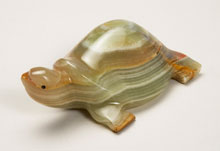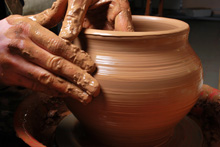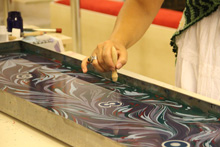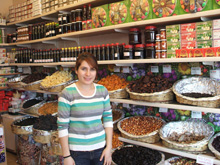- A practical guide to Cappadocia
- French
- English
Turkey is irresistible for the wide range of unique and beautiful crafts available and visiting the small shops of Cappadocia is a fun experience. You will certainly find something to take back as a gift for friends and family or just a souvenir for yourself. If you buy from the smaller family-run shops you can be sure that are are supporting the local economy. And it is fun! Don't ever feel pushed to buy, you can shop around, sit and drink tea, enjoy the contact with Turkish people and learn about traditional arts and crafts.
Traditional Turkish handicrafts include: rug-making, paper-marbling, cloth-weaving, tile-making, ceramics and pottery, embroidery, leather manufacture, musical instrument-making, copper work, basket-making, felt-making, weaving, woodwork, jewellery crafting, stone-carving etc.

Onyx is a natural volcanic stone of the agate family; much of it is mined in Cappadocia. It has a long history of use for hardstone carving and jewellery. Onyx comes in varying colours and quality (green is the best quality, followed by beige). A translucent stone marbled with concentric veins, it is crafted by local artisans into all sorts of decorative objects and jewellery. You can find turtles and dolphins, vases and bowls, chess sets, earrings, many different ideas for a present to bring back from Cappadocia, and at very reasonable prices.

Pottery has been produced in the Avanos area for centuries; the clay comes from the Kızılırmak (red river) which flows through Avanos and is the longest river in Turkey. In this sleepy little town, you will find a number of family-run pottery workshops where you can see a demonstration of a potter's kick-wheel and even try your hand at making something yourself. Souvenirs range from large plates to egg-cups, and the prices vary in consequence. In Ürgüp, in the cobbled pedestrian street, you will find El-se Çini Ceramics of Cappadocia. Selma Tagar is a professional ceramics designer and teacher and presents her original handmade, hand-glazed and hand-fired creations. She has an exquisite collection of reproductions of Hittite and Iznik designs and can on request make up your own design - the only person in Ürgüp to do this. All her ceramics are hand-fired in the traditional family oven.

Ebru or the art of paper marbling is the art of painting on water and transferring this painting onto paper producing patterns similar to smooth marble. Ox bile is added to the paint and water mix; this thickens and stabilises the paint and the design is delicately drawn across the surface using horsehair brushes. This ancient art was born in Central Asia where in Persian it was called ebri or ebru meaning "cloud". This art form was adopted in Anatolia and reached Europe at the beginning of the 17th century where it was known as "Turkish paper" or "Turkish marbling". Today there are very few artists who master ebru; Güler Somtürk in Cappadocia is one of them. She has is one of 15 experts in Turkey and one of only two experts to master the art of transferring the painting to silk. Güler now has her own art gallery "Kapadokya Ebru Sanat Evi" out on the Ortahisar road if you have a car, but she has kept her boutique in the high street in Ürgüp. I enjoy buying presents here (she has all sorts of paper designs, book marks, cards as well as silk scarves and ties, all unique designs) and I particularly enjoy watching her at work.

Turkish delight, dried or candied fruit or dried nuts are typical Turkish specialities and another good idea for a present (or just for yourself!). Turkish delight, lokum in Turkish, is one of the oldest forms of confectionery, originating in Istanbul during the Ottoman empire. Its fame soon spread to Europe, becoming a delicacy and a fashionable gift among the upper classes. Traditionally, lokum is flavoured with rose or lemon, but nowadays you can find virtually any sort of version: with pistachio nuts, hazelnuts, almonds, coconut, dried fruits... There are several shops selling this confectionery on the central square in Ürgüp, if you go in, you will be encouraged to try just about everything in the shop (if you don't have a sweet tooth, flee!). You will also find classical sun-dried fruits: apricots, for which Turkey is rightly famous, raisins and sultanas but also more unusual candied fruits like pumpkin (my favourite), grapefruit, melon or strawberry. Go on, you know you want to, have a taste!

Nazar boncuğu in Turkish: nazar, "evil eye" and boncuğu, "amulet". So it is an amulet which protects you against the evil eye. You will see this talisman everywhere in Turkey, over the entrance to houses and businesses, on baby clothes, dogs' collars, in taxis and buses, even over the entrance of McDonald's in Avanos! It is rather like a good luck sign, similar to four-leaved clovers, horseshoes or ladybirds. A typical nazar is made of handmade glass featuring concentric circles or tear-drop shapes in dark blue, white, light blue and black, occasionally with a yellow/gold edge. You will see them in all the souvenir shops, as necklaces, key-rings, bracelets, magnets.

An exquisite piece of gold and silver jewellery, with or without stone setting, is maybe something you are looking for. Gold and silver jewellery is always sold by weight. Surprisingly, although the prices of gold and silver are fixed internationally and sold by weight, jewellery items in Turkey are cheaper than other countries. This is due to the lower labour cost. A wide variety in design is available and the craftsmanship is of a high standard. The quality of gold in Turkey is excellent, 14, 18 or 22 carats, and should be accompanied with a authenticity certificate. In Ürgüp, the gold shops are in the road opposite Cappadocia Palace, behind the bus station. Otherwise you can find crafted jewellery made of semi-precious stones, of varying quality.
Top of Turkey © 2019. Designed by AE Teknoloji